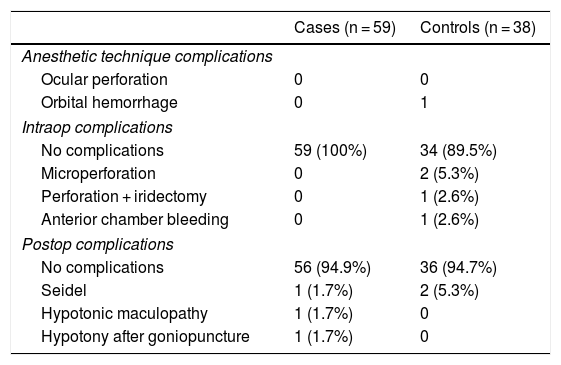To present a new anterior subtenonian anesthesia approach in the area of the future filtration bleb and its influence on medium term surgical success.
Material and methodsRetrospective study of 97 surgeries, deep sclerectomy (DS) or phaco-deep sclerectomy (PHACO-DS), were performed in patients with open angle glaucoma (OAG) comparing our modified “underbleb” subtenonian anesthesia (USA) (n = 58) versus a control group under peribulbar anesthesia (PA) (n = 38). Main outcomes were intraocular pressure (IOP), number of antiglaucomatous drugs and total and qualificated success, compared during 1, 3, 6, 12, 18 and 24 months follow up after glaucoma surgery.
ResultsBoth groups were comparable in terms of age, gender, surgical technique, number of antiglaucoma drugs and preoperative IOP. The IOP in the USA group decreased as in PA control group without statistical significant differences except at 24 months, where the IOP was 2 mm lower (14.83 ± 2.87 vs. 17.61 ± 4.27 (p = 0.009). This happened for both, DS and PHACO-DS surgeries. The number of postoperative drugs was lower at 3, 6, and 18 months but without statistically significant diferences. Tottal success at 24 months was higher in the ASA group respect AP control group (62.5% vs. 51.6) as well as partial success (100% vs. 71%).
ConclusionsOur new USA anesthetic technique doesn`t have a negative impact in deep sclerectomy medium-term surgical success, even it could contribute to it´s longer-term improvement.
presentar una nueva variante de anestesia subtenoniana, en el área quirúrgica de la futura ampolla de filtración y su influencia en el éxito quirúrgico a medio plazo.
Material y métodosestudio retrospectivo de 97 cirugías (EPNP o FACO-EPNP) realizadas en pacientes con glaucoma crónico simple (GCS) comparando aquellas realizadas bajo nuestra técnica de anestesia subtenoniana anterior modificada “subampular” (ASA) frente a otro grupo control bajo anestesia peribulbar (AP) (n = 58 vs 38). Se contrastaron la PIO, número de fármacos antiglaucomatosos y porcentaje de éxito total y parcial a 1, 3, 6, 12, 18 y 24 meses tras la cirugía.
Resultadosambos grupos fueron comparables en términos de edad, sexo, tipo de cirugía, numero de fármacos y PIO preoperatoria. La PIO en el grupo intervenido bajo ASA descendió de forma similar respecto al grupo control sin diferencias significativas salvo en los 24 meses, donde la PIO fue 2 mm menor 14,83 +/- 2,87 vs 17,61+/-4,27 p = 0,009. Esto sucedió tanto para EPNP como para la FACO-EPNP. El número de fármacos postoperatorios fue algo menor a los 3, 6, y 18 meses pero no estadísticamente significativo. El éxito total a los 24 meses fue mayor en el grupo de ASA respecto al control AP (62,5 % vs 51,6) al igual que el éxito parcial (100% vs 71%)
ConclusiónNuestra nueva técnica anestésica ASA no influye negativamente en el control tensional a medio plazo de la cirugía no perforante, sino que incluso podría contribuir al éxito quirúrgico a más largo plazo.












